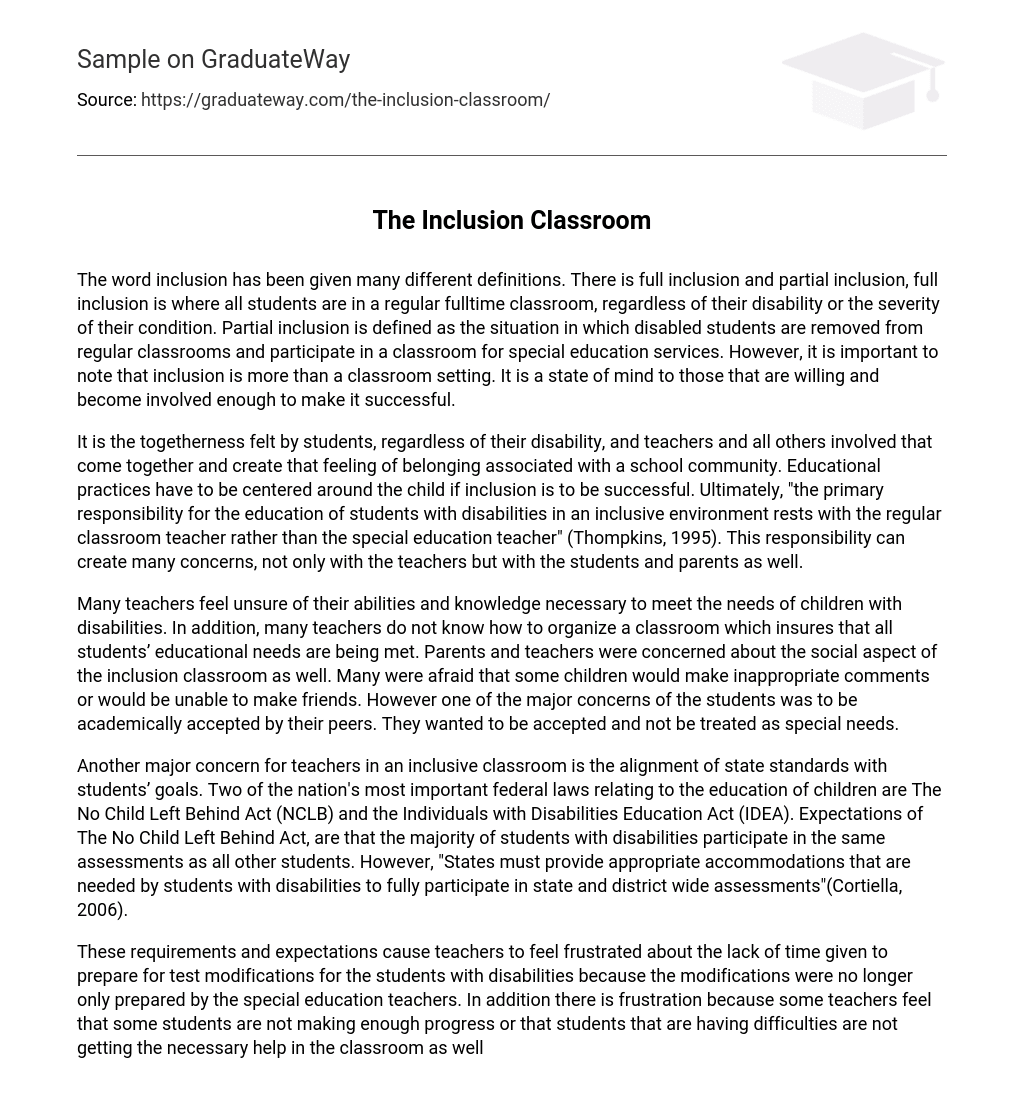The word inclusion has been given many different definitions. There is full inclusion and partial inclusion, full inclusion is where all students are in a regular fulltime classroom, regardless of their disability or the severity of their condition. Partial inclusion is defined as the situation in which disabled students are removed from regular classrooms and participate in a classroom for special education services. However, it is important to note that inclusion is more than a classroom setting. It is a state of mind to those that are willing and become involved enough to make it successful.
It is the togetherness felt by students, regardless of their disability, and teachers and all others involved that come together and create that feeling of belonging associated with a school community. Educational practices have to be centered around the child if inclusion is to be successful. Ultimately, “the primary responsibility for the education of students with disabilities in an inclusive environment rests with the regular classroom teacher rather than the special education teacher” (Thompkins, 1995). This responsibility can create many concerns, not only with the teachers but with the students and parents as well.
Many teachers feel unsure of their abilities and knowledge necessary to meet the needs of children with disabilities. In addition, many teachers do not know how to organize a classroom which insures that all students’ educational needs are being met. Parents and teachers were concerned about the social aspect of the inclusion classroom as well. Many were afraid that some children would make inappropriate comments or would be unable to make friends. However one of the major concerns of the students was to be academically accepted by their peers. They wanted to be accepted and not be treated as special needs.
Another major concern for teachers in an inclusive classroom is the alignment of state standards with students’ goals. Two of the nation’s most important federal laws relating to the education of children are The No Child Left Behind Act (NCLB) and the Individuals with Disabilities Education Act (IDEA). Expectations of The No Child Left Behind Act, are that the majority of students with disabilities participate in the same assessments as all other students. However, “States must provide appropriate accommodations that are needed by students with disabilities to fully participate in state and district wide assessments”(Cortiella, 2006).
These requirements and expectations cause teachers to feel frustrated about the lack of time given to prepare for test modifications for the students with disabilities because the modifications were no longer only prepared by the special education teachers. In addition there is frustration because some teachers feel that some students are not making enough progress or that students that are having difficulties are not getting the necessary help in the classroom as well as students missing necessary lessons because many teachers are teaching to the test.
As our text states, “Many educators believe that stripping away context denies the authenticity of the assessment— that is, it takes away any possible connection to the students’ lived experience”(Koch, 2011). Solutions to these problems and concerns may not be difficult to achieve. Workshops to train teachers can be brought about with proper funding. The desire to be successful along with a positive attitude can work wonders in the classroom. This along with the knowledge that exposing students to all kinds of situations better prepares them for the world.
Resources
Cortiella, C. (n. d. ). Tool Kit on Teaching and Assessing Students With Disabilities: Assessment. OSEP Ideas that Work. Retrieved March 10, 2012, from http://www. osepideasthatwork. org/parentkit/NCLBandIDEA. asp Koch, Janice. “Chapter 3: An Overview of Schooling in America. ” TEACH. Belmont, Calif. : Wadsworth; 2011. 57. Print. Thompkins, R. (1995, June). Inclusion: The Pros & Cons: Issues About Change. Issues About Change, 4. Retrieved March 10, 2012, from http://www. sedl. org/change/issues/issues43/definition_inclusion. html





